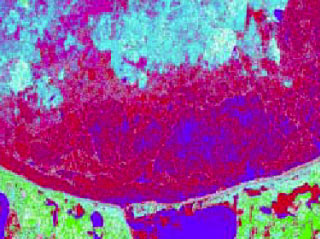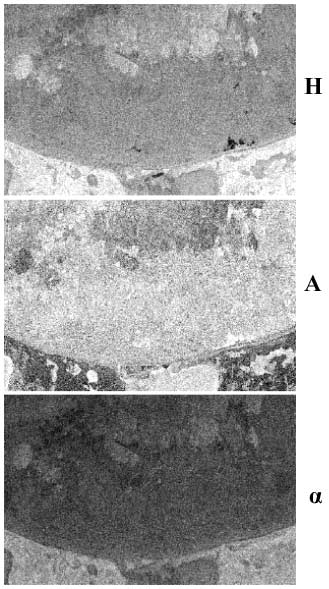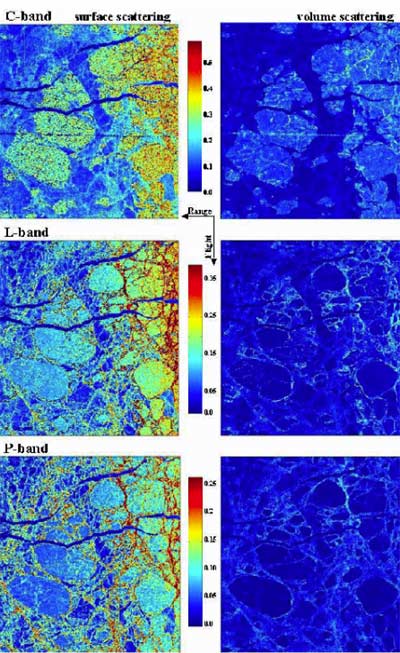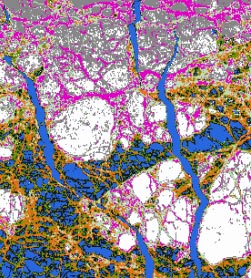Sea Ice Classification
The ability to perform robust and unambiguous ice type classification is critically important for operational applications and is one of the limitations of single channel SARs. Polarimetric SARs offer the potential of improved classification accuracy due to the increased information content of the additional polarizations and the phase data. Sea-ice classification methodologies for polarimetric SAR's are being developed and the results are demonstrating improved separability with the polarimetric response at both C- and L-bands. An example for C-band data acquired by the CV-580 off PEI in March 2001, is provided in Figure 22. It was found that while the multi-polarization data provided better class separability than single polarization data the fully polarimetric data provided enough information to provide an effective classification of the ice types.

Figure 9-22 |
|
| Colour Assignment | |
|---|---|
| Colours | Description |
| blue | Smooth, thin Fast Ice |
| red | Fast Ice with rough surface |
| magenta | Rough RYI |
| cyan | Rough, thicker FYI |
| white | Rough, thicker FYI / Land |
| green | Land |
| dark green | Land |
| black | Land |
| grey | Classes not used for comparison in the scatterplots (white dark green and black) |
Figure 9-22. Classified image of the north shore of PEI using CV-580 polarimetric C-band SAR data using a complex Wishart classifier with 8 initial classes and 12 iterations (from  ).
).
Polarimetric decomposition was used to illustrate the extra information content of the polarimetric data. Figure 9-23 shows the Entropy (H), Anisotropy (A), and Alpha( )-Angle for these data. The bottom image shows land, while fast ice is highlighted in the central image and rough first-year ice in the top image. Smooth ice shows the lowest entropy due to homogenous scattering whereas land has higher entropy. The anisotropy is lower for land and higher for ice providing the best contrast for land/ice and between ice types. The alpha-angle is low for smooth ice, which along with low entropy demonstrates surface scattering dominates. For rougher first year ice both the alpha angle and entropy are higher which, as demonstrated in the cross-polarization channel, indicates that more volume scattering is occurring.
)-Angle for these data. The bottom image shows land, while fast ice is highlighted in the central image and rough first-year ice in the top image. Smooth ice shows the lowest entropy due to homogenous scattering whereas land has higher entropy. The anisotropy is lower for land and higher for ice providing the best contrast for land/ice and between ice types. The alpha-angle is low for smooth ice, which along with low entropy demonstrates surface scattering dominates. For rougher first year ice both the alpha angle and entropy are higher which, as demonstrated in the cross-polarization channel, indicates that more volume scattering is occurring.

Figure 9-23
Figure 9-23. Entropy (H), Anisotropy (A), and Alpha ( )-Angle for images from C-band data acquired with the CV-580 off the North shore area of PEI in March, 2001. The bottom image shows land, while fast ice is highlighted in the centre image and rough first-year ice in the top image (from
)-Angle for images from C-band data acquired with the CV-580 off the North shore area of PEI in March, 2001. The bottom image shows land, while fast ice is highlighted in the centre image and rough first-year ice in the top image (from  ).
).

Did you Know?
Arctic sea ice data for 1953-1998 indicate that 6 of the 10 years of smallest ice extent have occurred since 1990, with increased regional variability in recent years. Summer 1998 was particularly unusual:. Open water formed earlier than in prior years, and the ice extent in September was 25 percent smaller than during the previous record minimum.
The use of fully polarimetric multi-frequency SAR such as the JPL AIRSAR is very attractive because the additional frequencies allow more target information to be extracted. For example the varying penetration characteristics allow further separability between ice types especially among multi-year ice types and first-year ice types. This can be illustrated by the use of multi-frequency polarimetric decomposition techniques to identify surface versus volume scattering target characteristics. Figure 9-24 shows the classification of surface versus volume scattering using this technique while Figure 9-25 provides the classification results. Future spaceborne SAR systems are planned at both C- and L-band which are expected to make multi-frequency polarimetric SAR imagery available in the not too distant future.

Figure 9-24
Figure 9-24. Total power images of the Freeman-Durden decomposition of C-L, and P-band AIRSAR data showing surface versus volume scattering (from  ).
).

Figure 9-25 |
||
| Class Assignment To Ice Types | ||
|---|---|---|
| Class | Colours | Description |
| ThI / SFYI | blue | new forming thin ice / Smooth first year ice |
| RFYI / R | orange green black |
Ridged first year ice / Rubble |
| CFYI | pink pastell green |
Compressed First Year Ice |
| MYI | white grey |
Multi Year Ice |
Figure 9-25. Ice type classification results using data acquired by the JLP AIRSAR. An entropy based polarimetric decomposition using eight classes and 12 iterations (from  ).
).
Whiz quiz

Question: What is the difference in scattering mechanism between new ice and multi-year ice? How would you use polarimetry to determine this? The answer is...
Whiz quiz - answer

Answer: New ice is dominated by surface scattering whereas multi-year ice has a large volume scattering component. The pedestal height would indicate the degree of roughness, the HV would help identify volume scattering and the polarimetric classification of scattering mechanisms could be used to determine areas of volume scattering.
Page details
- Date modified: